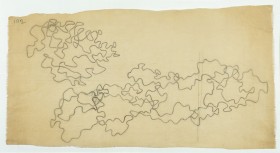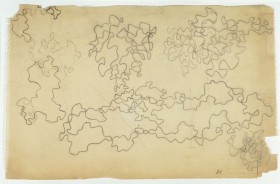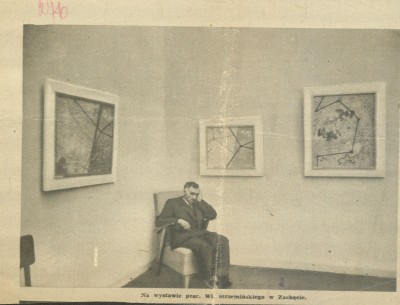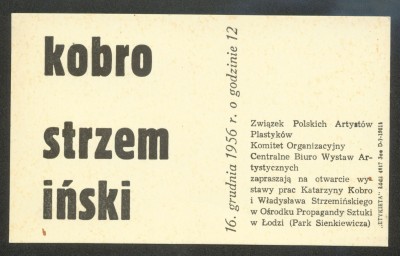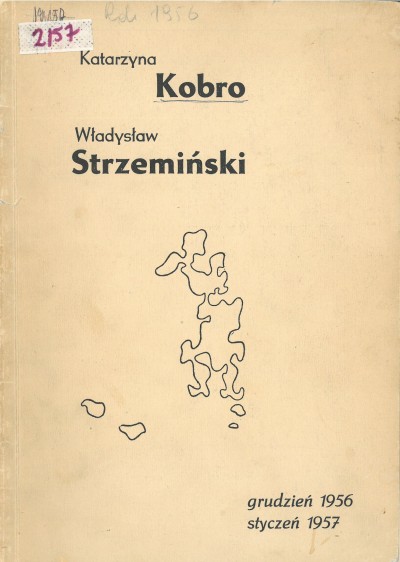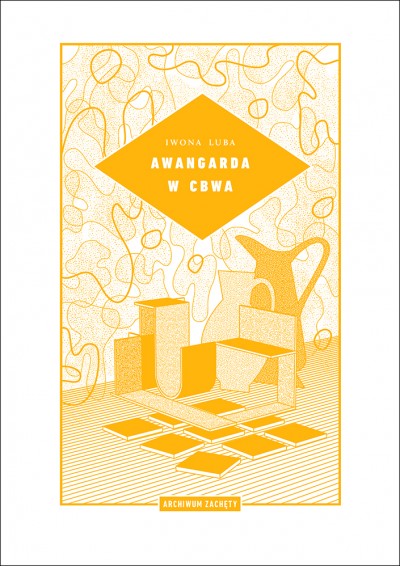Katarzyna Kobro — Władysław Strzemiński
18.01 – 10.02.1957 Katarzyna Kobro — Władysław Strzemiński
Zachęta Central Bureau of Art Exhibitions (CBWA)
Zachęta Central Bureau of Art Exhibitions (CBWA)
organisers: CBWA
attendance: no data available
additional information: The exhibition of works by Katarzyna Kobro and Władysław Strzemiński in December 1956–January 1957 was initially organised at the Bureau of Artistic Exhibitions in Łódź (Propaganda Institute, Sienkiewicza Park), from where it was moved to Warsaw
A total of 170 exhibits were put on display (Katarzyna Kobro: 12 sculptures, 1 painting on glass; Władysław Strzemiński: 77 paintings, 79 watercolours and drawings, 1 graphic illustration)
exhibition design: Marian Bogusz (and Jerzy Oplustil in Łódź)
poster design: Lech Kunka
display design for the Theory of Seeing: Stefan Krygier, Lech Kunka, Jerzy Mackiewicz
catalogue graphic design: Stefan Wegner
exhibition invitation: Stanisław Fijałkowski
text selection: Stanisław Fijałkowski, Antoni Starczewski, Bolesław Utkin
photograph selection: Eugeniusz Haneman
photography boards: Jerzy Mackiewicz
coordinator: Stefan Wegner
The preparation of the exhibition of works by Katarzyna Kobro (1898–1951) and Władysław Strzemiński (1893–1952) was a complicated affair with a number of surprising turns of events. As a result of the efforts undertaken by the organisers, it eventually took place in December 1956 at the Bureau of Art Exhibitions in Łódź.1 Even in September 1956, moving the exhibition to Warsaw was all but impossible, as stated by Gizela Szancerowa, Head of the Central Bureau of Art Exhibitions, whose statement on this issue was recorded as follows: ‘Due to the fact that Ms Szancerowa stated that there can be no exhibition of Strzemiński’s works in Warsaw in 1957, the best-developed exhibition is to be presented in Łódź.’2 Given the above, every effort was made to prepare the Łódź exhibition with utmost care and attention to detail, since it was considered a priority task at the time. The changes to Polish cultural policy in the first year of the political thaw process, which picked up pace after the events of October 1956, made it possible for the Katarzyna Kobro — Władysław Strzemiński exhibition to be held in Łódź, and in January 1957, to be opened in the building of the Zachęta Central Bureau of Art Exhibitions in Warsaw. Because of that, both the Łódź and Warsaw exhibitions had only one catalogue, which listed Łódź as the sole location.
The surviving minutes from the meetings of the exhibition organisation committee show that the joint exhibition of works by Katarzyna Kobro and Władysław Strzemiński was a contested matter, since the organisers found it difficult to decide whether their pieces should be shown in separate exhibition spaces or alongside each other. In the minutes, there is a record confirming that Kobro’s and Strzemiński’s works were to be displayed separately; however, the few remaining photographs show Kobro’s sculptures presented alongside Strzemiński’s paintings, as some parts of their respective oeuvres cannot be analysed and approached on their own. Sizeable excerpts from Kobro’s and Strzemiński’s joint text Composition of Space. Calculations of a Space-Time Rhythm complemented Strzemiński’s Architectural Compositions on display and in the catalogue.3 The members of the organisation committee, which mostly comprised people closely associated with Strzemiński, as well as many others who knew the couple, had difficulties with coming to terms with the fact that they had split in 1947. The majority of their surviving works were still located in the storehouses that housed the collection of the Muzeum Sztuki in Łódź, as well as the International Collection of Modern Art of the a.r. Group. Their condition at the time when the preparations for the exhibition in question started was mentioned by Stefan Krygier:
IN 1956, A MAJOR POSTHUMOUS EXHIBITION OF WORKS BY STRZEMIŃSKI AND KATARZYNA KOBRO IN ŁÓDŹ WAS PLANNED ON THE INITIATIVE OF JULIAN PRZYBOŚ. AT THAT TIME, I WAS INVOLVED IN THE TALKS AT MUZEUM SZTUKI IN ŁÓDŹ CONCERNING ORGANISATION MATTERS, TOGETHER WITH PROFESSOR STEFAN WEGNER AND JULIAN PRZYBOŚ. AT ONE POINT, JULIAN PRZYBOŚ EXPRESSED A DESIRE TO SEE THE COLLECTION IMMEDIATELY. AFTER WALKING INTO THE BASEMENT, WE SAW DUSTY, DIRTY AND GRIMY PAINTINGS WITH BROKEN GLASS COVERS, SCATTERED AROUND ON THE FLOOR. WHAT WE DID FIRST WAS TO MOVE THE COLLECTION TO THE GROUND FLOOR ROOM. NEVER IN MY LIFE HAVE I SEEN JULIAN PRZYBOŚ AS ANGRY AS HE WAS WHEN HE HELPED US MOVE THE WORKS ON THAT DAY4
Marian Minich, the director of Muzeum Sztuki in Łódź, participated in the meetings of the organisation committee in 1956;5 he was also the one who approved lending a considerable number of works by both Kobro and Strzemiński for the Warsaw and Łódź exhibitions. Formally, the organisation committee comprised: Ryszard Stefańczyk, Stefan Wegner, Bolesław Utkin, Stefan Krygier, Jerzy Oplustil, Lech Kunka, Jakobina Strzemińska, Nora Szczepańska, Tadeusz Roman (painter, head of the Łódź Branch of the Central Bureau of Art Exhibition, formal exhibition organiser) and young art historian Janina Ładnowska — representatives of Łódź’s artist milieu, mostly painters (including numerous of Strzemiński’s students associated with the State School of Fine Arts in Łódź.6 Additionally, the meetings were attended by other people, including the aforementioned Gizela Szancerowa and Henryk Stażewski, who — like Przyboś — was a former member of the a.r. group.
The catalogue included a number of texts, including ‘Strzemiński’s Innovation’ by Julian Przyboś and ‘Biographical Memories’ by Stefan Wegner.7 It also contained the ‘List of Works by Władysław Strzemiński’, prepared by Irena Treichel with contributions by Wanda Polakowska,8 as well as ‘List of Works by Katarzyna Kobro’, prepared by Bolesław Utkin.9
Due to the prestigious nature of the exhibition, much attention was paid to even the tiniest details of the exhibition and its catalogue, starting with the script, selection of works and theoretical texts, up to its layout and arrangement of works.10 This becomes clear from the analysis of the meeting minutes and the end result — the exhibition and its catalogue. The exhibition script was developed by Marian Bogusz and Jerzy Oplustil. At that time, Bogusz was already a distinguished Warsaw-based artist of the young generation, co-founder of the 55 Group (1955) and the Krzywe Koło Gallery, as well as an active set designer. In the 1940s, he headed the Young Artists’ and Scientists’ Club, and Władysław Strzemiński was one of its guests at the time. In the late 1940s Jerzy Oplustil worked with Strzemiński and some of his students, with whom he designed several public spaces and exhibition pavilions.
The exhibition script envisaged presenting the entire oeuvre by Strzemiński — his works of art supplemented with theoretical texts, which constituted an integral part of the display and the catalogue. The innovative approaches employed by both Kobro and Strzemiński were highlighted in the script, and then brought out by the exhibition design.
The detailed script, which bore Bogusz’s signature, envisaged works being displayed in a ‘chronological order according to the development of their art’, along with a separate space dedicated to ‘Strzemiński’s main theoretical work, The Theory of Seeing’. The script outlined a number of periods in the artist’s life — Cézanne-ism, cubism, neoplasticism (space-time), unism, hyperrealism, solaristic compositions (after-images), leaving room for his paintings and compositions from the final period. In every single one of these individual spaces, the artist’s works were accompanied by his theoretical texts, while the part of the exhibition devoted to The Theory of Seeing had a ‘separate script’.11
The exhibition was invaluable due to the fact that it constituted the first attempt to reconstruct a list-catalogue of works by Kobro and Strzemiński, both surviving and lost, establish which museums and private collectors had them in their collections, as well as assess their state at that time, reflecting their significance in the past decade. It was also an important starting point for the initial development of Strzemiński’s biography and the bibliography of texts by both Strzemiński and Kobro, which is — unfortunately — still considered comprehensive, in spite of the time that passed since then. Right from the outset, the exhibition was also conceived as a place where Strzemiński’s Theory of Seeing was to be shown publicly for the first time, as the crowning piece of his artistic, teaching and intellectual activity.
Placing Strzemiński’s death mask in the first room, right at the entrance made the entire display feel like a posthumous tribute, further highlighted in the very name of the exhibition — thus further highlighting its solemn nature and shaping the relationship between the viewer and the works in a sense.
The exhibition of works by Katarzyna Kobro and Władysław Strzemiński in the Łódź Branch of the Central Bureau of Art Exhibitions at the Art Propaganda Centre at Sienkiewicza Park 4 opened on 16 December 1956. The invitation bears the names of three organisers — Union of Artists and Designers, Organisational Committee and the Central Bureau of Art Exhibitions.
It remains unclear as to when exactly it became possible to move the exhibition to Warsaw and to display the works by Kobro and Strzemiński at the Zachęta Central Bureau of Art Exhibitions in Warsaw, where it was open to the public from 18 January to 10 February 1957. Like in Łódź, Marian Bogusz was responsible for the exhibition design, while the poster was designed by Lech Kunka. 170 works in total were exhibited.12 The records preserved in the State Archive in Łódź and the Institutional Archive of the Zachęta — National Gallery of Art offer no information about moving the exhibition to Warsaw; however, it had to take place in late autumn, after the events of October 1956, as a result of joint efforts undertaken by the organisers of the Łódź exhibition, chief among them being Gizela Szancerowa as the head of the Central Bureau of Art Exhibitions, as well as Julian Przyboś, as Stefan Krygier recalled 30 years later: ‘After Strzemiński’s death, J. Przyboś was the greatest promoter of his art; contributing to having Strzemiński’s and Kobro’s exhibition moved to Warsaw. I regret that the beautiful and deeply heartful speech delivered by Przyboś during the official opening at Zachęta was not recorded.’13 It is however highly probable that it reflected the same tone as the first article, entitled ‘Conclusions and Proposals’, that Przyboś wrote about Strzemiński in the wake of the political thaw in autumn of 1955, in which he stated:
LOOKING FORWARD TO THE FUTURE, STRZEMIŃSKI — THE INNOVATOR AND PIONEER — KNEW THAT THERE IS NO GOING BACK IN ART HISTORY, JUST LIKE IN THE HISTORY OF ANY OTHER HUMAN ENDEAVOUR. IN HIS EFFORTS TO BRING ABOUT A UNIVERSAL ART, HE SET NEW PATHS LEADING TO THE RESTORATION OF THE SOCIAL FUNCTION OF PAINTING. . . . THE UNIVERSAL NATURE OF ART WILL NOT BE BROUGHT ABOUT BY DROVES OF PEOPLE SEEING ONE PAINTING, REGARDLESS IF TINY OR ENORMOUS; INSTEAD, IT WILL HINGE UPON OUR ENTIRE SURROUNDINGS BEING DESIGNED AND SHAPED LIKE PAINTINGS, UPON US LIVING WITHIN PAINTINGS. THIS IS THE CONCEPT OF UNIVERSAL ART, AS STRZEMIŃSKI ENVISIONED, PROMOTED IN HIS BOOKS AND PIONEERED IN HIS WORKS, IN WHICH ART CEASES TO BE SOMETHING SPECIAL, BECOMING ORDINARY AND COMMON.
THESE DAYS, SIMILAR IDEAS ARE PROMOTED AND PURSUED BY THE FRENCH ‘ESPACE’ COLLECTIVE, WHICH BRINGS TOGETHER ARCHITECTS, ENGINEERS, PAINTERS, SCULPTORS, FURNITURE DESIGNERS AND MORE, WHO WANT TO BRING ABOUT THE ARTISTIC INTEGRATION OF EVERYDAY LIFE. JUST LIKE STRZEMIŃSKI AND HIS GROUP, THEY MAKE ATTEMPTS AT LINKING AND MERGING ALL KINDS OF ARTISTIC ACTIVITIES INTO ONE INDIVISIBLE ART UNIVERSE — JUST NOT TO THE SAME EXTENT AS STRZEMIŃSKI AND HIS GROUP . . . .
HOWEVER, ART IS BASED ON CREATION — MEANING ONE’S OWN EFFORT AND PURSUIT, NOT THAT OF OTHERS. BY ONE’S OWN I MEAN THE HIGHEST LEVEL OF VISUAL AWARENESS, WHICH WAS ACHIEVED ONLY BY THE MOST EMINENT OF CONTEMPORARY ARTISTS, WHO DID NOT IMITATE WORKS BY OTHERS, BUT CO-CREATED THIS CREATIVE INNOVATION IN THE ARTISTIC AVANT-GARDE OF THE WORLD, WHICH RESULTED IN FRENCH ARTISTS — PICASSO, LÉGER AND THE ‘ESPACE’ COLLECTIVE, STRZEMIŃSKI [AND] THE ‘PRAESENS’ GROUP IN POLAND, AS WELL AS RIVIERA’S WALL PAINTINGS IN MEXICO.’14
Paradoxically, the exhibition of works by Kobro and Strzemiński in Warsaw was far less popular among the media and critics/art historians compared to the earlier display in Łódź, which was even recorded in a short clip found in the National Film Archive. From the historical, political and artistic perspective, the exhibition at Zachęta constituted an official approval of the artists’ works, theories on art and other activities aimed at promoting avant-garde art in Poland, including the establishment of the a.r. International Collection of Modern Art and the design of the Neoplastic Room for the Muzeum Sztuki in Łódź in one of the final strokes of creative freedom by Strzemiński. The institutional recognition — a display at Zachęta, which at that time constituted the most important exhibition space for contemporary art in Poland — had an intrinsic value.
Iwona Luba
Institute of Art History of the University of Warsaw
This compilation was prepared as part of the National Programme for the Development of Humanities of the Polish Minister of Science and Higher Education — research project The History of Exhibitions at Zachęta — Central Office of Art Exhibitions in 1949–1970 (no. 0086/NPRH3/H11/82/2014) conducted by the Institute of Art History of the University of Warsaw in collaboration with Zachęta — National Gallery of Art.
translated by Paulina Bożek
Bibliography
Exhibition catalogues:
- Katarzyna Kobro — Władysław Strzemiński, exh. cat., 18 January–10 February 1957. Łódź, 1957
- Władysław Strzemiński 1893–1952. W setną rocznicę urodzin, 25 November 1993–16 January 1994. Łódź: Muzeum Sztuki w Łodzi, 1993
Periodicals:
- Etler, E. ‘Lekcja Władysława Strzemińskiego’, 7 reproductions. Kronika (Warsaw), no. 1, 1957
- Fijałkowski, S., T. Kantor, A. Marczyński, S. Wegner, M. Włodarski. ‘O Władysławie Strzemińskim’. Przegląd Artystyczny, no. 1, 1957, p. 3–18, illus. (19 reproductions)
- Grubert, H. ‘Tylko mityczny Argus gdy patrzył „tu” — widział wszystko „tam”. Każdy człowiek widzi tylko to, na co patrzy aktualnie’. Express Wieczorny, no. 33, 1957, illus. by Julian Żebrowski
- Koniusz, J. ‘Z wystawy Strzemińskiego’. Nadodrze, no. 2, 1958, p. 3
- Ledóchowski, S. ‘O Strzemińskim, unizmie i teorii widzenia’. Słowo Powszechne, no. 41, 1957, p. 4, illus.
- Makowski, Z. ‘O Strzemińskim’ Kierunki (Warsaw), no. 7, 1957, illus.
- Osęka, A. ‘Malarstwo w poszukiwaniu nowego kształtu życia’. Trybuna Ludu, no. 11, 1957, illus.
- Przeworska, H. ‘Wystawa pośmiertna Władysława Strzemińskiego i Katarzyny Kobro’. Stolica, no. 1, 1957, p. 7, illus.
- Przyboś, J. ‘Realizm „rytmu fizjologicznego”’. Przegląd Kulturalny Warsaw, no. 4, 1957, illus.
- Rocznik CBWA 1957. Warsaw, pp. 8–9, illus. 6 (poster for the exhibition of Katarzyna Kobro and Władysław Strzemiński in Warsaw, design: Lech Kunka, photo: Witalis Wolny).
- Sochacka, D. ‘Każdemu wedle jego… smaku’. Głos Wybrzeża (Gdańsk) no. 34, 1957, illus.
- Sochacka, D. ‘Każdemu według jego… smaku’. Gazeta Robotnicza, supplement Sprawy i Ludzie, no. 6, 1957, p. 3, illus.
- Up. ‘Spacer po salach wystawowych’. Trybuna Mazowiecka, no. 20, 1957, p. 2
- Wat, A.‘Z wystaw w Zachęcie. Malarstwo Władysława Strzemińskiego’, Głos Pracy, no. 33, 1957, illus. (1 reproduction)
- Wat, A. ‘Koniec mitu’. Przegląd Kulturalny Warsaw, no. 8, 1957
- Witz, I. ‘Strzemiński i Kobro w „Zachęcie”’. Życie Warszawy, no. 35, 1957, p. 8
- ‘Wystawa pośmiertna Strzemińskiego i Kobro’. Projekt, no. 1, 1957, p. 32
- ‘Wystawa prac Katarzyny Kobro i Władysława Strzemińskiego’. Życie Literackie, no. 4, 1957, p. 12
- Z. H. ‘Władysław Strzemiński’. Twórczość, no. 3, 1957
- ZOIL Zdziwiony. ‘Snobizm i jąkanie’. Życie Literackie, no. 8, 1957, p. 10–11
Non-serial publications:
- Luba, I. Awangarda w CBWA. Exhibitions by Katarzyna Kobro and Władysław Strzemiński, Henryk Stażewski, Maria Ewa Łunkiewicz-Rogoyska from 1956 to 1969. Warsaw: Zachęta — National Gallery of Art, 2017. 172 pages, 59 illus., bibliography, selection of source materials, index of names (part of the 2017. Stulecie awangardy celebrations of the centennial of the avant-garde)
Archive materials:
- State Archive in Łódź, fonds 2400, Bureau of Art Exhibitions in Łódź, no. 296, Department of Publishing and Documentation 1956–1957: Wystawa Katarzyny Kobro i Władysława Strzemińskiego XII 1956–I 1957, [n.pag.].
- Institutional Archive of Zachęta — National Gallery of Art
- Documentation department of Zachęta — National Gallery of Art
- National Film Archive, film from the exhibition of Katarzyna Kobro and Władysław Strzemiński in Łódź
1 State Archive in Łódź, fonds 2400, Bureau of Artistic Exhibitions in Łódź, no. 296, Department of Publishing and Documentation 1956–1957: Wystawa Katarzyny Kobro i Władysława Strzemińskiego XII 1956–I 1957, [n.pag.].
2 Ibid.
3 Katarzyna Kobro. Władysław Strzemiński, exh. cat., December 1956–January 1957, Łódź: Ośrodek Propagandy Sztuki, 1956, p. 25.u
4 Stefan Krygier, ‘Jakim go znałem…’, Sztuka, no. 6, 1986, p. 27.
5 State Archive in Łódź, fonds 2400.
6 Ibid.
7 Julian Przyboś, ‘Nowatorstwo Strzemińskiego’, in Katarzyna Kobro. Władysław Strzemiński, pp. 3–11; S. Wegner, ‘Wspomnienia biograficzne’, in ibid., pp. 12–17.
8 Katarzyna Kobro. Władysław Strzemiński, p. [2].
9 Ibid., p. 67.
10 State Archive in Łódź, fonds 2400, p. [3].
11 Ibid., [n.pag.].
12 Katarzyna Kobro: 12 sculptures, 1 painting on glass; Władysław Strzemiński: 77 paintings, 79 watercolours and drawings, 1 graphic work.
13 Krygier, p. 27.
14 Julian Przyboś, ‘Wnioski i propozycje’, Przegląd Kulturalny, no. 43, 1955.
Katarzyna Kobro — Władysław Strzemiński
18.01 – 10.02.1957
Zachęta Central Bureau of Art Exhibitions (CBWA)
pl. Małachowskiego 3, 00-916 Warsaw
See on the map
